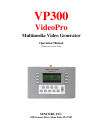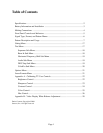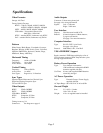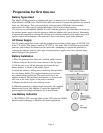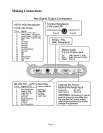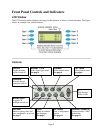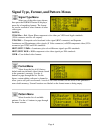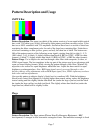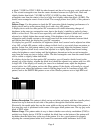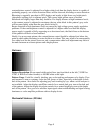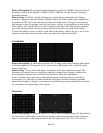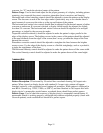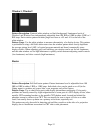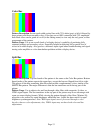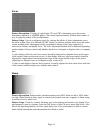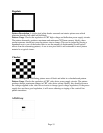
Page 7
Pattern Description and Usage
SMPTE Bar
Pattern Description: The upper two-thirds of the pattern consists of seven equal-width vertical
bars, with 75% white (gray) at left, followed by three primary and three seconday colors. Color
bars are at 100% saturation with 75% amplitude. Just below these bars is a section of short bars
containing the blues complement color for each of the large bars containing blue. Under those
color bars containing no blue (yellow, green, and red), the short bar is black. The bottom one-
fifth of the pattern consists of the following seven signals, starting from left to right; 1) -I, 2)
100% white, 3) -Q, 4) black, 5) slightly blacker than black (0 IRE for NTSC, -4 IRE for other
formats), 6) black, 7) slightly whiter than black (10 IRE for NTSC, +4 IRE for other formats).
Pattern Usage: Use to adjust color and hue through a blue filter with composite, S-video, or
YPbPr signal inputs. The bar transitions in the top part of the picture may be an advantage with
some on-screen-display formats. While viewing the pattern through a blue filter (Wratten 50),
adjust the color control for equal brightness white/blue bars. Adjust the hue control for equal
brightness cyan/magenta bars. Note: RGB input signals aren’t processed through a color
decoder, thus no color adjustments with an RGB input signal; also, YPbPr inputs may not have
both color and hue adjustments.
Also use this pattern to adjust a display’s black level at a medium APL. With the brightness
(black level) control first adjusted to a slightly higher than normal setting, reduce the brightness
control setting until the slightly blacker than black bar (under the large cyan bar) and the black
bar (under the large red bar) are both just black. The slightly whiter than black bar (under the
large blue bar) should still be slightly visible.
Pluge
Pattern Description: The Pluge pattern (Picture Line-Up Generator Eguipment – BBC
development) is arranged in four concentric rectangular zones. The innermost rectangle is fixed



